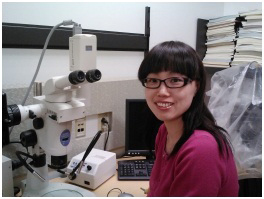专家信息:
梁岩,女,浙江大学农业与生物技术学院生物技术研究所研究员,国家“青年**计划”学者。
教育及工作经历:
1994.9 – 1998.7,东北农业大学植物保护专业,学士学位。
1998.9 – 2001.7,浙江大学植物病理学专业,硕士学位。
2002.1 – 2007.2,美国佛蒙特大学(University of Vermont)植物学专业,博士学位。
2007.2-2011.10,中科院遗传与发育生物学研究所,助理研究员。
2011.12-2015.2,美国密苏里大学植物学系,博士后研究。
主讲课程:
本科生课程:《基础植物病理学》
研究生课程:《科技论文写作》
培养研究生情况:
1. 王敏 植物病理学
2. 孙勋 植物病理学
招聘情况:
浙江大学农业与生物技术学院梁岩课题组招聘博士后启事
浙江大学农业与生物技术学院生物技术所梁岩课题组因科研工作需要,诚招博士后研究人员2名。课题组主要研究植物与微生物互作中几丁质与脂质几丁质寡糖的分子识别机制(参考文献:Liang et al., 2013, Science, 341:1384-1387)。
1、招聘要求
国内重点院校具有博士学位的毕业生,或国外知名大学留学回国人员,具有遗传学、生物化学、农学或细胞生物学等相关学科背景;具有较强的科研能力,能够独立完成相关研究课题。有较强的中英文写作能力,能够熟练阅读英文专业文献;工作勤奋,进取心和责任感强,具有良好的团队合作精神;年龄要求在35岁以下。
2、研究方向
根瘤菌结瘤因子的识别机制;几丁质介导的植物抗病的分子机制;非豆科植物与根瘤菌的互作。
3、岗位待遇:
按学校有关规定,另加课题组业绩奖励。
联系人:梁岩
E-mail:yanliang@zju.edu.cn
联系地址:浙江大学农业与生物技术学院生物技术所
邮编:310058
研究方向:
植物与微生物互作中几丁质(chitooligosaccharides)与脂质几丁质寡糖(lipochitooligosaccharides) 的分子识别机制。
植物与微生物在长期共进化过程中形成两种截然不同的关系:有些微生物被植物识别为敌人,即病原菌,植物通过识别病原菌的保守结构以及分泌的效应因子,从而诱导天然免疫反应,进而限制病原菌的进一步扩展;相反,有些微生物被植物识别为朋友,即有益菌,植物关闭天然免疫反应,与微生物建立互利互惠的关系。因此植物与微生物关系的建立是由植物识别微生物信号分子决定的。本实验室主要研究植物与微生物互作的识别机制,重点集中在植物区分病原菌和共生菌的分子机制,主要包括以下两个项目:
1)植物识别病原菌和共生菌脂多糖的分子机理。脂多糖俗称为内毒素,是革兰氏阴性菌细胞壁的主要成分。在病原细菌中,脂多糖是重要的病原相关分子模式,可以激活动植物细胞的先天免疫反应。然而根瘤菌的脂多糖被认为是侵染豆科植物形成根瘤所必须的。因此我们将进一步深入研究脂多糖分子在诱导植物先天免疫和介导共生中的作用机理。
2)豆科植物识别结瘤因子的进化机制。豆科植物与根瘤菌共生可以将大气中的氮转变为氨,为植物提供直接利用的氮源,这对减少化肥用量和农业的可持续发展有着非常重要的意义。建立这种共生关系的关键是豆科植物识别根瘤菌分泌的结瘤因子。豆科植物识别结瘤因子的受体与非豆科植物识别几丁质和丛枝菌因子的受体密切相关,它们都属于LysM蛋白家族,但几丁质作为真菌的信号分子诱导植物免疫反应,丛枝菌因子介导大部分植物与丛枝菌共生。鉴于几丁质、丛枝菌因子和结瘤因子结构上的相似性和受体的同源性,因此我们对比研究植物对几种信号分子的识别,最终从分子上阐明豆科植物结瘤因子受体的进化机制。
承担科研项目情况:
资料更新中……
科研成果:
1. 发现非豆科植物可以识别结瘤因子,但识别的结果是抑制植物的抗病反应。在根瘤形成过程中,结瘤因子是由LYK蛋白家族识别的。对拟南芥中LYK家族突变体的筛选发现,lyk3突变体中结瘤因子不能抑制抗病。这一结果证明,拟南芥lyk3是介导结瘤因子抑制抗病的关键基因,暗示着非豆科植物中存在根瘤菌结瘤因子的受体。
2. 发现了拟南芥中识别几丁质的受体模式与豆科植物识别根瘤菌结瘤因子模式非常相似,它们都通过LYK蛋白家族识别,这为研究根瘤菌结瘤因子受体的生化机制提供了依据。非豆科植物的固氮研究一步一步推进,其前景也越来越明朗。
3. 根瘤菌结瘤因子的分子骨架与存在于真菌细胞壁中的几丁质寡聚体很相似,梁岩发现,作为共生的信号分子,识别几丁质寡聚糖类分子的受体可能起源于同一个祖先,几丁质的受体识别模式可能是介导根瘤菌共生信号分子受体识别模式的起源。因而,在非豆科植物中研究几丁质的信号转导,将对改造非豆科植物识别结瘤因子有很重要的现实意义。
代表性英文论文:
Publications (#Co-first author, *Corresponding author)
(52) DGK5β-derived phosphatidic acid regulates ROS production in plant immunity by stabilizing NADPH oxidase.
Qi, F.#, Li, J.#, Ai, Y., Shangguan, K., Li, P., Lin, F.*, and Liang, Y.* (2024) Cell Host & Microbe 32, 1-16 https://www.sciencedirect.com/science/article/pii/S1931312824000155
website_figures(1)_00.jpg
Press Release in Chinese:
https://mp.weixin.qq.com/s/3z7kdL3DY74habRqXYcESA
https://mp.weixin.qq.com/s/YyQxBOn88Vhi_rhwJgrsuQ
https://mp.weixin.qq.com/s/WBsZopTSw2LCAl64f4mgEw
(51) Reversible phosphorylation of a lectin-receptor-like kinase controls xylem immunity.
Wang, R.#, Li, C.#, Jia, Z., Su, Y., Ai, Y., Li, Q., Guo, X., Tao, Z., Lin, F.*, and Liang, Y.* (2023) Cell Host Microbe 31, 1953-1955.
https://doi.org/10.1016/j.chom.2023.10.017
website_figures_00.jpg
Spotlight in English:
Macho, A.P. (2023). Walking down the phosphorylation path to root immunity. Cell Host Microbe 31, 1953-1955. https://doi.org/10.1016/j.chom.2023.11.013
Press Release in Chinese:
https://mp.weixin.qq.com/s/WKh6wPD2Tjqy3Ikz4WzAKg
https://mp.weixin.qq.com/s/WfUVgIzEsuRecjmLPRt0xg
(50) Fuels for ROS signaling in plant immunity.
Wu, B., Qi, F., and Liang, Y.* (2023). Trends Plant Sci 13, S1360-1385.
https://doi.org/10.1016/j.tplants.2023.04.007
website_figures_01.jpg
Hot papers (0.1%):
Press Release in Chinese:
https://mp.weixin.qq.com/s/f34Txni9mIxqEYt26g7bPA
(49) Ascorbate peroxidase 1 allows monitoring of cytosolic accumulation of effector-triggered reactive oxygen species using a luminol-based assay.
Hong, X., Qi, F., Wang, R., Jia, Z., Lin, F., Yuan, M., Xin, X.F., and Liang, Y.* (2023). Plant Physiol 191, 1416-1434.
https://doi.org/10.1093/plphys/kiac551
website_figures_02.jpg
Spotlight in English:
Ugalde, J.M. (2023). The echo from outside: ASCORBATE PEROXIDASE 1 modulates cytosolic effector-triggered reactive oxygen species. Plant Physiol. https://doi.org/10.1093/plphys/kiad089
Press Release in Chinese:
https://mp.weixin.qq.com/s/KNKQOOMdrYrUVEUy06RDQw
(48) RALF22 promotes plant immunity and amplifies the Pep3 immune signal.
He, Y.H., Chen, S.Y., Chen, X.Y., Xu, Y.P., Liang, Y., and Cai, X.Z. (2023). J Integr Plant Biol 65, 2519-2534.
https://doi.org/10.1111/jipb.13566
Press Release in Chinese:
https://mp.weixin.qq.com/s/pQvkfmv40np9Zx5vPJVYCg
(47) Tomato LysM receptor kinase 4 mediates chitin-elicited fungal resistance in both leaves and fruit.
Ai, Y., Li, Q., Li, C., Wang, R., Sun, X., Chen, S., Cai, X.Z., Qi, X., and Liang, Y.* (2023). Hortic Res 10, uhad082.
https://doi.org/10.1093/hr/uhad082.
website_figures_03.jpg
Press Release in Chinese:
https://mp.weixin.qq.com/s/N4sG2YYvOmoTPBed779Pyg
https://mp.weixin.qq.com/s/mLu7s2zDI6W99dlXXy8lLA
(46) Overexpression of an antioxidant enzyme APX1 in cpr5 mutant restores its pleiotropic growth phenotype.
Qi, F., Li, J., Hong, X., Jia, Z., Wu, B., Lin, F., and Liang, Y.* (2023). Antioxidants (Basel) 12: 301.
https://doi.org/10.3390/antiox12020301
website_figures_04.jpg
(45) Research progress on the regulation of vascular lignification on defense against bacterial wilt of plants. (In Chinese with English abstract)
Li, C., Wang, R., and Liang, Y.* (2023). Journal of Zhejiang University (Agriculture and Life Sciences), 49(5): 633-643.
Press Release in Chinese:
https://mp.weixin.qq.com/s/ZJ14ksCDv7zDs5hjqZTyag
https://mp.weixin.qq.com/s/_paqgkuNCkbu29l9UgEZ0Q
(44) Endophytic fungus Falciphora oryzae enhances salt tolerance by modulating ion homeostasis and antioxidant defense systems in pepper.
Zou, Y., Zhang, L., Liu, R., He, L., Hu, Z., Liang, Y., Lin, F., Zhou, Y.* (2023) Physiologia Plantarum, 175:e14059.
https://doi.org/10.1111/ppl.14059
(43) The receptor-like cytosolic kinase RIPK activates NADP-malic enzyme 2 to generate NADPH for fueling the ROS production.
Wu, B., Li, P., Hong X., Xu C., Wang R., and Liang Y.* (2022). Mol Plant, 15:887-903.
https://doi.org/10.1016/j.molp.2022.03.003
website_figures1_06.jpg
Faculty Opinions Recommendation, 23 Mar 2022
Press Release in Chinese:
https://mp.weixin.qq.com/s/DI_raO9rc_2z1q-IrxqUMQ
(42) Warm temperature compromises JA-regulated basal resistance to enhance Magnaporthe oryzae infection in rice.
Qiu, J., Xie, J., Chen, Y., Shen, Z., Shi, H., Naqvi, N.I., Qian, Q., Liang, Y., and Kou, Y. (2022). Mol Plant 15, 723-739.
https://doi.org/10.1016/j.molp.2022.02.014
Press Release in Chinese:
https://mp.weixin.qq.com/s/7HP-22ADufOksDhpzQaB2w
(41) Tomato receptor-like cytosolic kinase RIPK confers broad-spectrum disease resistance without yield penalties.
Wang, R., Li, C., Li, Q., Ai, Y., Huang, Z., Sun, X., Zhou, J., Zhou, Y., and Liang, Y.* (2022). Hortic Res 9, uhac207.
https://doi.org/10.1093/hr/uhac207
website_figures1_07.jpg
Press Release in Chinese:
https://mp.weixin.qq.com/s/_20u5SQ-k5FoTLXXtBIqPg
(40) His-Ala-Phe-Lys peptide from Burkholderia arboris possesses antifungal activity.
Zhu, H., Xu, C., Chen, Y., and Liang, Y.* (2022). Front Microbiol 13, 1071530.
https://doi.org/10.3389/fmicb.2022.1071530
website_figures1_08.jpg
(39) Real-time monitoring of Ralstonia solanacearum infection progress in tomato and Arabidopsis using bioluminescence imaging technology.
Xu, C., Zhong, L., Huang, Z., Li, C., Lian, J., Zheng, X., and Liang, Y.* (2022). Plant Methods 18, 7.
https://doi.org/10.1186/s13007-022-00841-x.
website_figures1_09.jpg
(38) Maintaining Symbiotic Homeostasis: How do plants engage with beneficial microorganisms while at the same time restricting pathogens?
Thoms, D., Liang, Y., and Haney, C.H. (2021). Mol Plant Microbe Interact 34, 462-469.
https://doi.org/10.1094/MPMI-11-20-0318-FI
(37) The receptor-like cytoplasmic kinase RIPK regulates broad-spectrum ROS signaling in multiple layers of plant immune system.
Li, P., Zhao, L., Qi, F., Htwe, N., Li, Q., Zhang, D., Lin, F., Shang-Guan, K., and Liang, Y.* (2021). Mol Plant 14, 1652-1667.
https://doi.org/10.1016/j.molp.2021.06.010
website_figures1_10.jpg
Spotlight in English:
Liu, D., Luo, D., and He, P. (2021). ROS around RIPK. Mol Plant 14, 1607-1609. https://doi.org/10.1016/j.molp.2021.07.019.
Singh, P., Mishra, V., Tripathi, D.K., Corpas, F.J., and Singh, V.P. (2022). RIPK: a crucial ROS signaling component in plants. Trends Plant Sci 27, 214-216. https://doi.org/10.1016/j.tplants.2021.12.001.
Highly cited paper (1%):
Press Release in Chinese:
https://mp.weixin.qq.com/s/dnFom6nAYDKAh4_MLFrD_w
https://mp.weixin.qq.com/s/p0sqHz86mT2Wc3Yzvl1AMw
https://mp.weixin.qq.com/s/I63_RWHChStRjsYsrUk64w
(36) Improved functional expression of cytochrome P450s in saccharomyces cerevisiae through screening a cDNA library from Arabidopsis thaliana.
Jiang, L., Dong, C., Liu, T., Shi, Y., Wang, H., Tao, Z., Liang, Y., and Lian, J. (2021). Front Bioeng Biotechnol 9, 764851.
https://doi.org/10.3389/fbioe.2021.764851
(35) Construction and application of luminescent strain of Pectobacterium carotovorum harboring luxCDABE operon. (In Chinese with English abstract)
Zhong, L., Xu, C., Huang, Z., An, Q., and Liang, Y.* (2021). Journal of Zhejiang University (Agriculture and Life Sciences), 47(5): 566-576.
http://www.zjujournals.com/agr/CN/10.3785/j.issn.1008-9209.2021.02.221 http://www.zjujournals.com/agr/CN/Y2021/V47/I5/566
website_figures1_11.jpg
Press Release in Chinese
https://mp.weixin.qq.com/s/9UROFJ9TadesbOi0hc-9Ug
(34) Optimal temporal-spatial fluorescence techniques for phenotyping nitrogen status in oilseed rape.
Sun, D., Xu, H., Weng, H., Zhou, W., Liang, Y., Dong, X., He, Y., and Cen, H. (2020). J Exp Bot 71, 6429-6443.
https://doi.org/10.1093/jxb/eraa372
(33) Endophytic fungus Falciphora oryzae promotes lateral root growth by producing indole derivatives after sensing plant signals.
Sun, X., Wang, N., Li, P., Jiang, Z., Liu, X., Wang, M., Su, Z., Zhang, C., Lin, F., and Liang, Y.* (2020). Plant Cell Environ 43, 358-373.
https://doi.org/10.1111/pce.13667
website_figures1_12.jpg
(32) Design and application of a rotatory device for detecting transient Ca2+ signals in response to mechanical stimulation using an aequorin-based Ca2+ imaging system.
Peng, Y., Zheng, Y., Zhou, J., Shang-Guan, K., Wang, H., and Liang, Y.* (2020). Curr Protoc Plant Biol 5, e20116.
https://doi.org/10.1002/cppb.20116
website_figures1_13.jpg
Before 2020
(31) Antepenultimate residue at the C-terminus of NADPH oxidase RBOHD is critical for its function in the production of reactive oxygen species in Arabidopsis.
Li, Q.Y., Li, P., Myint Phyu Sin Htwe, N., Shangguan, K.K., and Liang, Y.* (2019). J Zhejiang Univ Sci B 20, 713-727.
https://doi.org/10.1631/jzus.B1900105
(30) Lipopolysaccharide perception and signaling in plant immunity. (In Chinese with English abstract)
Li, Q., Wang, M., Wu, B., and Liang Y.* (2019) Plant Physiol J 2019, 55 (4): 387–392
https://doi.org/10.13592/j.cnki.ppj.2019.0059
(29) Lipopolysaccharides trigger two successive bursts of reactive oxygen species at distinct cellular locations.
Shang-Guan, K., Wang, M., Htwe, N., Li, P., Li, Y., Qi, F., Zhang, D., Cao, M., Kim, C., Weng, H., Cen, H., Black, I.M., Azadi, P., Carlson, R.W., Stacey, G., Liang, Y.* (2018). Plant Physiol 176, 2543-2556.
https://doi.org/10.1104/pp.17.01637
(28) Tomato LysM receptor-like kinase SlLYK12 is involved in arbuscular mycorrhizal symbiosis.
Liao, D., Sun, X., Wang, N., Song, F., and Liang, Y.* (2018). Front Plant Sci 9, 1004.
https://doi.org/10.3389/fpls.2018.01004
(27) Arabidopsis E3 ubiquitin ligase PLANT U-BOX13 (PUB13) regulates chitin receptor LYSIN MOTIF RECEPTOR KINASE5 (LYK5) protein abundance.
Liao, D.#, Cao, Y.#, Sun, X., Espinoza, C., Nguyen, C.T., Liang, Y.*, and Stacey, G.* (2017). New Phytol 214, 1646-1656.
https://doi.org/10.1111/nph.14472
(26) Chitin receptor CERK1 links salt stress and chitin-triggered innate immunity in Arabidopsis.
Espinoza, C., Liang, Y., and Stacey, G. (2017). Plant J 89, 984-995.
https://doi.org/10.1111/tpj.13437
(25) Involvement of a putative bipartite transit peptide in targeting rice pheophorbide a oxygenase into chloroplasts for chlorophyll degradation during leaf senescence.
Xie, Q.#, Liang, Y.#, Zhang, J., Zheng, H., Dong, G., Qian, Q., and Zuo, J. (2016). J Genet Genomics 43, 145-154.
https://doi.org/10.1016/j.jgg.2015.09.012
(24) Neglecting legumes has compromised human health and sustainable food production.
Foyer, C.H., Lam, H.M., Nguyen, H.T., Siddique, K.H., Varshney, R.K., Colmer, T.D., Cowling, W., Bramley, H., Mori, T.A., Hodgson, J.M., Cooper, J.W., Miller, A.J., Kunert, K., Vorster, J., Cullis, C., Ozga, J.A., Wahlqvist, M.L., Liang, Y., Shou, H., Shi, K., Yu, J., Fodor, N., Kaiser, B.N., Wong, F.L., Valliyodan, B., Considine, M.J. (2016). Nat Plants 2, 16112.
https://doi.org/10.1038/nplants.2016.112
(23) Rice ferredoxin-dependent glutamate synthase regulates nitrogen-carbon metabolomes and is genetically differentiated between japonica and indica subspecies.
Yang, X., Nian, J., Xie, Q., Feng, J., Zhang, F., Jing, H., Zhang, J., Dong, G., Liang, Y., Peng, J., et al. (2016). Mol Plant 9, 1520-1534.
https://doi.org/10.1016/j.molp.2016.09.004
(22) Identification of homogentisate dioxygenase as a target for vitamin E biofortification in oilseeds.
Stacey, M.G., Cahoon, R.E., Nguyen, H.T., Cui, Y., Sato, S., Nguyen, C.T., Phoka, N., Clark, K.M., Liang, Y., Forrester, J., et al. (2016). Plant Physiol 172, 1506-1518.
https://doi.org/10.1104/pp.16.00941
(21) The Arabidopsis CROWDED NUCLEI genes regulate seed germination by modulating degradation of ABI5 protein.
Zhao, W., Guan, C., Feng, J., Liang, Y., Zhan, N., Zuo, J., and Ren, B. (2016). J Integr Plant Biol 58, 669-678.
https://doi.org/10.1111/jipb.12448
(20) Cytokinin antagonizes abscisic acid-mediated inhibition of cotyledon greening by promoting the degradation of abscisic acid insensitive 5 protein in Arabidopsis.
Guan, C., Wang, X., Feng, J., Hong, S., Liang, Y., Ren, B., and Zuo, J. (2014). Plant Physiol 164, 1515-1526.
https://doi.org/10.1104/pp.113.234740
(19) Lipochitooligosaccharide recognition: an ancient story.
Liang, Y., Toth, K., Cao, Y., Tanaka, K., Espinoza, C., and Stacey, G. (2014). New Phytol 204, 289-296.
https://doi.org/10.1111/nph.12898
(18) The kinase LYK5 is a major chitin receptor in Arabidopsis and forms a chitin-induced complex with related kinase CERK1.
Cao, Y.#, Liang, Y.#, Tanaka, K., Nguyen, C.T., Jedrzejczak, R.P., Joachimiak, A., and Stacey, G. (2014). eLife 3, e03766
https://doi.org/10.7554/eLife.03766
(17) Extracellular ATP, a danger signal, is recognized by DORN1 in Arabidopsis.
Choi, J., Tanaka, K., Liang, Y., Cao, Y.R., Lee, S.Y., and Stacey, G. (2014). Biochemical Journal 463, 429-437.
https://doi.org/10.1042/Bj20140666
(16) Identification of a plant receptor for extracellular ATP.
Choi, J., Tanaka, K., Cao, Y.R., Qi, Y., Qiu, J., Liang, Y., Lee, S.Y., and Stacey, G. (2014). Science 343, 290-294.
https://doi.org/10.1126/science.343.6168.290
(15) Nonlegumes respond to rhizobial Nod factors by suppressing the innate immune response.
Liang, Y., Cao, Y., Tanaka, K., Thibivilliers, S., Wan, J., Choi, J., Kang, C., Qiu, J., and Stacey, G. (2013). Science 341, 1384-1387.
https://doi.org/10.1126/science.1242736
(14) miR172 regulates soybean nodulation.
Yan, Z., Hossain, M.S., Wang, J., Valdes-Lopez, O., Liang, Y., Libault, M., Qiu, L., and Stacey, G. (2013). Mol Plant Microbe Interact 26, 1371-1377.
https://doi.org/10.1094/MPMI-04-13-0111-R
(13) Role of LysM receptors in chitin-triggered plant innate immunity.
Tanaka, K., Nguyen, C.T., Liang, Y., Cao, Y., and Stacey, G. (2013). Plant Signal Behav 8, e22598.
https://doi.org/10.4161/psb.22598
(12) Arabidopsis transcription factor genes NF-YA1, 5, 6, and 9 play redundant roles in male gametogenesis, embryogenesis, and seed development.
Mu, J., Tan, H., Hong, S., Liang, Y., and Zuo, J. (2013). Mol Plant 6, 188-201.
https://doi.org/10.1093/mp/sss061
(11) Deletion of the initial 45 residues of ARR18 induces cytokinin response in Arabidopsis.
Liang, Y., Wang, X., Hong, S., Li, Y., and Zuo, J. (2012). J Genet Genomics 39, 37-46.
https://doi.org/10.1016/j.jgg.2011.12.004
(10) Programmed cell death may act as a surveillance mechanism to safeguard male gametophyte development in Arabidopsis.
Zhang, J., Teng, C., and Liang, Y.* (2011). Protein Cell 2, 837-844.
https://doi.org/10.1007/s13238-011-1102-6
(9) A putative transporter is essential for integrating nutrient and hormone signaling with lateral root growth and nodule development in Medicago truncatula.
Yendrek, C.R., Lee, Y.C., Morris, V., Liang, Y., Pislariu, C.I., Burkart, G., Meckfessel, M.H., Salehin, M., Kessler, H., Wessler, H., et al. (2010). Plant J 62, 100-112.
https://doi.org/10.1111/j.1365-313X.2010.04134.x
(8) Arabidopsis histidine kinase CKI1 acts upstream of histidine phosphotransfer proteins to regulate female gametophyte development and vegetative growth.
Deng, Y., Dong, H., Mu, J., Ren, B., Zheng, B., Ji, Z., Yang, W.C., Liang, Y., and Zuo, J. (2010). Plant Cell 22, 1232-1248.
https://doi.org/10.1105/tpc.108.065128
(7) The Arabidopsis PARAQUAT RESISTANT2 gene encodes an S-nitrosoglutathione reductase that is a key regulator of cell death.
Chen, R.#, Sun, S.#, Wang, C.#, Li, Y.#, Liang, Y.#, An, F., Li, C., Dong, H., Yang, X., Zhang, J., and Zuo, J. (2009). Cell Res 19, 1377-1387.
https://doi.org/10.1038/cr.2009.117
(6) Genome-wide comparative analysis of type-A Arabidopsis response regulator genes by overexpression studies reveals their diverse roles and regulatory mechanisms in cytokinin signaling.
Ren, B., Liang, Y., Deng, Y., Chen, Q., Zhang, J., Yang, X., and Zuo, J. (2009). Cell Res 19, 1178-1190.
https://doi.org/10.1038/cr.2009.88
(5) LEAFY COTYLEDON1 is a key regulator of fatty acid biosynthesis in Arabidopsis.
Mu, J., Tan, H., Zheng, Q., Fu, F., Liang, Y., Zhang, J., Yang, X., Wang, T., Chong, K., Wang, X.J., and Zuo, J. (2008). Plant Physiol 148, 1042-1054.
https://doi.org/10.1104/pp.108.126342
(4) Abscisic acid coordinates nod factor and cytokinin signaling during the regulation of nodulation in Medicago truncatula.
Ding, Y., Kalo, P., Yendrek, C., Sun, J., Liang, Y., Marsh, J.F., Harris, J.M., and Oldroyd, G.E. (2008). Plant Cell 20, 2681-2695.
https://doi.org/10.1105/tpc.108.061739
(3) Advances in Arabidopsis research in China from 2006 to 2007.
Liang, Y., Zuo, J.*, and Yang, W.* (2007). Chinese Science Bulletin 52, 1729-1733.
https://doi.org/10.1007/s11434-007-0274-1.
(2) Abscisic acid rescues the root meristem defects of the Medicago truncatula latd mutant.
Liang, Y., Mitchell, D.M., and Harris, J.M. (2007). Dev Biol 304, 297-307.
https://doi.org/10.1016/j.ydbio.2006.12.037.
(1) The LATD gene of Medicago truncatula is required for both nodule and root development.
Bright, L.J., Liang, Y., Mitchell, D.M., and Harris, J.M. (2005). Mol Plant Microbe Interact 18, 521-532.
https://doi.org/10.1094/MPMI-18-0521
荣誉奖励:
1、2015年入选国家“青年**计划”。
中国科技创新人物云平台暨“互联网+”科技创新人物开放共享平台(简称:中国科技创新人物云平台)免责声明:
1、中国科技创新人物云平台是:“互联网+科技创新人物”的大型云平台,平台主要发挥互联网在生产要素配置中的优化和集成作用,将互联网与科技创新人物的创新成果深度融合于经济社会各领域之中,提升实体经济的创新力和生产力,形成更广泛的以互联网为基础设施和实现工具的经济发展新形态,实现融合创新,为大众创业,万众创新提供智力支持,为产业智能化提供支撑,加快形成经济发展新动能,促进国民经济提质增效升级。
2、中国科技创新人物云平台暨“互联网+”科技创新人物开放共享平台内容来源于互联网,信息都是采用计算机手段与相关数据库信息自动匹配提取数据生成,并不意味着赞同其观点或证实其内容的真实性,如果发现信息存在错误或者偏差,欢迎随时与我们联系,以便进行更新完善。
3、如果您认为本词条还有待完善,请编辑词条。
4、如果发现中国科技创新人物云平台提供的内容有误或转载稿涉及版权等问题,请及时向本站反馈,网站编辑部邮箱:kjcxac@126.com。
5、中国科技创新人物云平台建设中尽最大努力保证数据的真实可靠,但由于一些信息难于确认不可避免产生错误。因此,平台信息仅供参考,对于使用平台信息而引起的任何争议,平台概不承担任何责任。

















